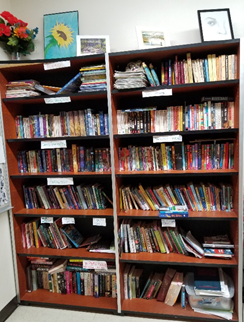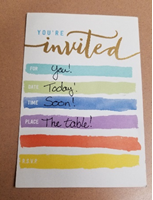|
By Donna Davidson, Northwest Director for NDCTE Connected Newsletter, April 2020
Will anyone notice if I just don’t do laundry for the rest of the month? Will I ever need to fill my car with gas again? Should I bother showering today? These are the questions I’m asking myself in the Age of Corona. I would love to spend this time telling you about the amazing things I’m doing in class and the great resources I have to share, but I don’t have any. I frequently think about all the things I should have time for now. The books! The research! The projects! And then I spend the next 1200 hours scrolling through Facebook and realize that everybody else’s quarantine projects are way cooler than mine. This is the tale of vacillating wildly between emotions. Sometimes I stare zombie-like at the computer screen trying desperately to be productive or lie in bed wondering if it’s worth even getting up. Other times, I work obsessively on a project for hours. I cry. I laugh. I cry again. Down. Up. Down. Up. Down. Up. It’s a roller coaster, and I’ve never liked amusement parks. In our efforts to cope, it’s really tempting to always try to look on the bright side, isn’t it? We feel like we need to capture every negative thought and beat it into submission until it whimpers out something about a silver lining. Look on the bright side: my students and I have all learned more about digital connective technology in the past month than we had in the previous five years. Look on the bright side: at least it’s spring so we can be outside. Look on the bright side: we’re going to have so much more appreciation for all the things we take for granted right now, like time with friends and dinner parties and high fives. All of those things are true, but it’s also true that this stinks and I am not happy a lot of the time, a fact which no amount of positive thinking, video chats, or funny cat memes can fix. The abrupt change to our careers and personal lives hits everyone differently, but we’re all in mourning for something—the loss of our students’ daily presence, the loss of our favorite activities, the loss of personal connection in our lives. We’re mourning the loss of freedom, of hugs, of toilet paper. So we, being the emotionally intelligent creatures that we are, acknowledge that loss, grieve, put it aside, and push on, congratulating ourselves for our resilience. Then the next day, we’re struck by that loss all over again, and have to grieve again and find a way to keep pushing on. And so the roller coaster rolls on. I know other people have already said this elsewhere and better, but I’m going to join the chorus and advocate for not finding the positive in this situation for just a moment. Instead, be honest with each other about whatever it is that’s got us down. We will get through this with faith, hope, and love, but we won’t get through it without tears or frustration. We won’t get through it without feeling sad or inadequate sometimes, and we may have to revisit those losses that we thought we’d already put behind us. We may not be our best and most innovative teacher selves. We may not be as cool as the people with the fancy blogs on Facebook. We may have enough personal griefs to work through—and then work through again—that sometimes it’s hard to even think about teaching. It would be nice to put some great advice here, but I have none to give. I’m too busy mourning my own losses. Instead, I’ll just tell you that I love you and I’m proud of whatever you’re doing to make things work.
1 Comment
Nicholas Strom, teacher from West Fargo High School, shared a resource with NDCTE: Parlay.
Parlay is a digital round table discussion platform designed to for both synchronous and asynchronous learning. For online round tables, teachers can select from the "universal library" which includes teacher shared prompts and Parlay made prompts -- these prompts are editable and customizable for your content needs. Round tables allow for multi media integration (e.g. embed videos). If students are asked to reply to their peers, the platform also provides sentence stems to help students create meaningful comments and responses. Parlay https://parlayideas.com/ Parlay Google Drive Resource Folder https://drive.google.com/open?id=1btY3bRN7Fyt_lbKR5f9SE4mWcCrjZMt_ Roll out for students is simple: They are provided a link to join your round table, sign in as a student using their School e-mail, and then they can participate in the discussion. Students identities can be made anonymous which allows for student replies to be focused on the content of their peers as opposed to who actually wrote the post. It also seems to track student conversations in a pretty nifty way (Data collection). On their website, Parlay has announced that they are offering their service for free until at least May 15th. The freshmen PLC at WFHS is looking at this to potentially help track online student attendance and deliver weekly big idea prompts. Thank you, Nicolas for sharing this resource with us! by Lisa Gusewelle, Member-at-Large for NDCTE Connected Newsletter, Oct. 2019 Each year that we teach, we hope that we have moved past last year's problems and are smarter, tougher, and awesomer. What we usually realize is that while we may know our material and our schedule a bit better there will always be challenges that will test just how smart, how tough, and how awesome we really are. Perhaps nothing may test a teacher's constitution than a student who finds the teacher to be the dumbest, weakest, and lamest of all people that they have ever met in their life.
Some ways that a student may cut a teacher down:
1. Play "the dum-dum." Teachers are often too afraid of looking dumb, which is unfortunate as this can be our greatest relationship- building tool and academic strategy. Students already realize that we are smart, so don't worry about them mistaking you for being an actual dum-dum. The aim of playing "the dum-dum" is to put our students in position to feel smart. Many lesson plans make sure to include reading, writing, speaking, and listening, but most unit plans do not include a time to make students feel like winners or like geniuses. Whenever I complete my version of student projects, I always make glaring (often hilarious) mistakes in mine. What my mistake-ridden project says to students is "here is a project that you can easily do better than, and here are some not-to-dos to make your project better than mine." 2. Be a sportscaster. Acknowledge your students' actions by narrating their actions and feelings like an announcer and sportscaster. Example: Student says, "This is dumb." Teacher responds, "You think that this is dumb." Students says, "Yeah, I'm not going to be able to finish it, and I have a game tonight." Teacher responds, "You're worried that you won't have enough time." 3. Give your students a time-in. Want to know why one-on-one reading conferences are the most rewarding part of your students' school day? You're gifting them and only them your time and attention and it matters even if it is only 1- or 3-minutes in length. 4. Access the students' conscious need to be good by going through the side door. My elementary students rarely do well their first time doing something. Sometimes they're spectacularly awful! One way to improve is by doing a Jeffrey Wilhelm "Notice & Note." Observe what you saw that was good and add a "because" statement. For example, I might say, "I really liked when [student] asked why. She could have responded by ignoring her and repeating back her own thoughts, which some students did do, but instead, she took interest in an opinion different than hers and made the conversation better." Then, provide all students an extra opportunity to do better. Another way to go through the side door is by giving your students an opportunity to role-play the negative behavior. Example: Teacher says, "You're with someone who is not working with you on your project. What would you say to them? Let's do a think-pair-share. All right, let's share out on what we might say." After discussion, the teacher will select two students based on their responses to the prompt. One role will be the student who wants to work together and the other role will be the student who is being unhelpful. Play out the scene and then ask the class what they observed and if the discussion would be helpful in future situations. *I have also seen the above done with Barbies, which sounds so silly, but was actually AMAZING! It allowed the students to focus more on how to respond to the situation rather than what their peers were thinking of them in the role play. 5. Let your students catch you gossiping about them, and let it be good gossip! If you're really struggling, think of what maybe drives you the craziest about the student. Example: Teacher says to parent on phone, "I love your student's energy. He is so much fun. I can see why his classmates like him. I dislike having to tell him to get in his seat so often because he is a really great kid." 6. Practice patience-stretching. Our most attention-seeking students struggle badly with patience. When a student is constantly bouncing up and down in your face and is speaking loudly, a teacher's blood pressure soars. Set a timer for 1, 2, or 3 minutes, and say, "I really want to hear what you have to say, but I am busy right now. I will give you my full attention as soon as this timer goes off." Make sure that when the timer does go off that you do allow the student to have your attention. If they continue talking during the hold time, have them do their patience stretching outside of the classroom, but keep the timer yourself in case a student wants to give themselves an extended break. Please remember when you are teaching THAT student that even though they make your day more challenging and even though they will never give you a card that reads "Your the best teacher ever," they are your student, not the principal's, not the office secretary's, but yours. Sure they may be smelly, whiney, consistently on the ineligible list, and no one else wants them, but THAT student is yours. More importantly, success or failure with THAT student does not take away from the fact that you are the smartest, toughest, most awesome teacher in the room. And, I really and truly believe in you. NDCTE President Bridget Ryberg shares about using Flipgrid for independent reading! NDCTE President Bridget Ryberg shares how she incorporates independent reading in her classroom! Watch, learn, and share your ideas in the comments below! **Helpful links Bridget shares in her video include: Kelly Gallagher's website: http://www.kellygallagher.org/ Ryberg/Haaven Creative Thinkers: https://docs.google.com/document/d/1QfkeK0Dz3V6BzcuohjkYxccJKke4fiGwvCqlAoteG5g/edit?usp=sharing NDCTE President Bridget Ryberg shares her independent reading awesomeness:
How do you use independent reading in your classes? |


 RSS Feed
RSS Feed
